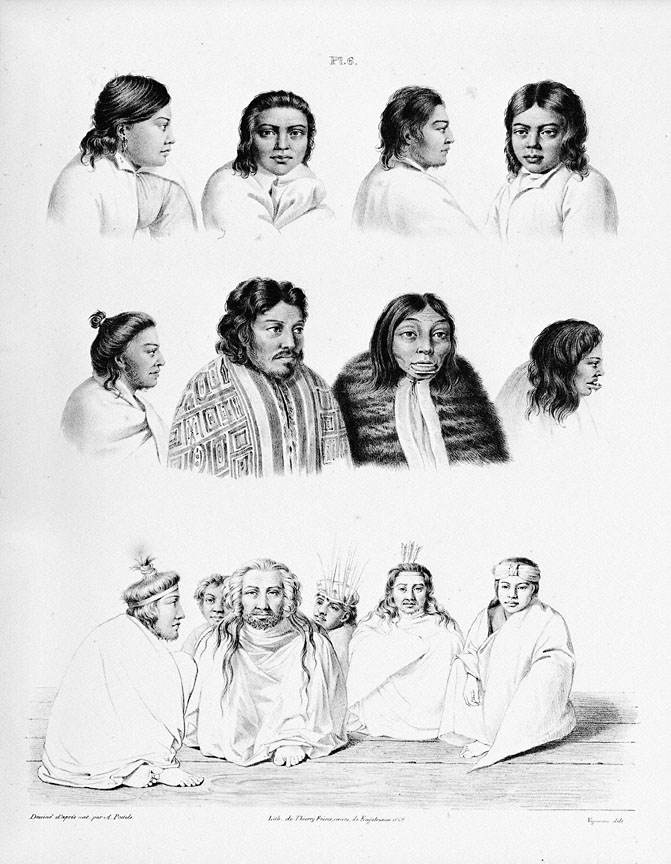- Catalog No. —
- OrHi 8207
- Date —
- 1835
- Era —
- 1792-1845 (Early Exploration, Fur Trade, Missionaries, and Settlement)
- Themes —
- Arts, Environment and Natural Resources, Native Americans
- Credits —
- Oregon Historical Society
- Regions —
- None
- Author —
- Alexandr Postels
Les Caloches
This engraving by the French firm Thierry Frères is based on a sketch by the Russian scientist Alexandr Postels. It was included in the atlas accompanying Fedor Petrovich Litke’s multi-volume work Voyage Autour du Monde (Voyage Around the World), published in 1835—1836.
The French title for this engraving, Les Caloches, Habitants de l’Ile Sitka, translates in English as “the Kolosh, inhabitants of Sitka Island.” Kolosh was the Russian term for the Tlingit peoples who lived along the Alaskan coastline south of present-day Icy Bay. From the 1740s through the early 1790s, independent Russian fur traders concentrated their activities in the Aleutian Islands and the Gulf of Alaska. In the process, they instituted a brutal forced labor system upon the Aleutian Islanders, who were superb sea otter hunters. In the mid-1790s, the Russians moved into the territory of the Tlingit, taking Aleut hunters with them to exploit local sea otter populations. In June 1799 Alexander Baranov, commander of the new Russian American Company, arrived at Sitka Island with company personnel and a contingent of some 550 Aleut hunters. He established a colonial settlement on the island, which he named Arkhangelsk (Archangel). Tensions with the local Tlingit populations developed almost immediately, and in July 1802 the Tlingit destroyed the Russian outpost. Baranov re-established the settlement as Novoarhangelsk (New Archangel) on a nearby promontory that was more easily defended.
In extending their colonial system into the Alaska panhandle, the Russians encountered a formidable enemy in the Tlingit. The Tlingit fiercely resisted Russian attempts to restrict their movements, control their labor, regulate trade with American fur traders, and abuse their women—all elements of Russian rule in the Aleutian Islands. Owing to the Russians’ small numbers and long supply lines, they were dependent on both the Native peoples and American traders for their survival. In contrast, the Tlingit enjoyed both demographic superiority and a wealth of natural resources. They also proved adept at driving hard bargains with the Russians, opting to trade with visiting American ships if the Russians would not meet their demands. Another advantage enjoyed by the Tlingit was their ability to obtain guns and powder from the Americans. Demonstrating a willingness to adapt traditional practices to new technologies, the Tlingit continually harassed the Russians and their Aleut laborers, often ambushing hunting and fishing parties. In this way the Tlingit people maintained their independence and their traditional way of life throughout the Russian colonial period (1790s—1867).
Further Reading:
Gibson, James. “Bostonians and Muscovites on the Northwest Coast, 1788-1841.” In The Western Shore: Oregon Country Essays Honoring the American Revolution. Portland, Oreg., 1976, 81—120.
Gibson, James. Otter Skins, Boston Ships, and China Goods: The Maritime Fur Trade of the Northwest Coast, 1785-1841. Seattle, Wash., 1992.
Gibson, James. “Russian Dependence on the Natives of Alaska.” In Russia’s American Colony. Edited by S. Frederick Starr, 1987. Durham, N. C., 77—104.
Written by Melinda Jette, © Oregon Historical Society, 2003
